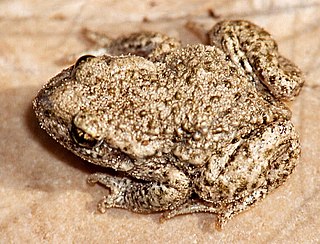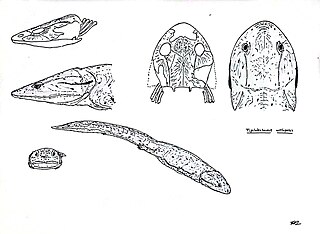
The Alytidae are a family of primitive frogs. Their common name is painted frogs or midwife toads. Most are endemic to Europe, but three species occur in northwest Africa, and a species formerly thought to be extinct is found in Israel.
The Bostobe Formation is a geological formation in Qaraghandy & Qyzylorda, Kazakhastan whose strata date back to the Late Cretaceous.

Arcadia is an extinct genus of temnospondyl amphibians in the family Rhytidosteidae from the early Triassic. The remains were found in and named after the Arcadia Formation of Australia.
Indolyrocephalus is an extinct genus of prehistoric amphibian belonging to the family Trematosauridae. It contains a single species, I. huxleyi, from the Early Triassic Panchet Formation of India. It was initially classified in Gonioglyptus, then into its own genus Indolyrocephalus, and then back into Gonioglyptus, but is presently placed in Indolyrocephalus once again.
Nannospondylus is an extinct genus of dvinosaurian temnospondyl within the family Trimerorhachidae. It is known from the Chickasha Formation in Oklahoma.
Lisserpeton is an extinct genus of prehistoric salamander of the Hell Creek Formation. Its closest living relatives are the mole salamanders.

Kourerpeton is an extinct genus of dvinosaurian temnospondyl. Fossils of Kourerpeton were discovered in a window of a barber's shop in either Bisbee or Mesa, Arizona. Kourerpeton was named in 1976, with the type and only species being K. bradyi. It was originally assigned to the monotypic family Kourerpetidae, which has been alternatively spelled Kourerpetontidae.

Rewana is an extinct genus of prehistoric temnospondyls. Two species have been described from the Arcadia Formation of Australia.
Wellesaurus is an extinct genus of mastodonsauroid temnospondyl. They were amphibious carnivores that lived in freshwater environments.
Plagiorophus is an extinct genus of plagiosaurid temnospondyl amphibian. It is known from the Middle Triassic Bukobay Formation (Ladinian) and Donguz Formation (Anisian) of Russia.
Plagiobatrachus is an extinct genus of plagiosaurid temnospondyl. It is known from the Rewan Formation, an Early Triassic formation in Australia.
Peltostega is an extinct genus of prehistoric trematosaurians. The type is the only known species, Peltostega erici It is known from the Early Triassic Kongressfjellet Formation of Svalbard and Jan Mayen.

Tupilakosaurus is an extinct genus of dvinosaurian temnospondyl within the family Tupilakosauridae.

Sinobrachyops placenticephalus is an extinct temnospondyl amphibian from Middle Jurassic-aged Shaximiao Formation in the Sichuan basin, China.
Syndyodosuchus is an extinct genus of temnospondyl within the family Actinodontidae. It is known from the Permian Inta Formation of European Russia.
Stoschiosaurus is an extinct genus of trematosaurian temnospondyl within the family Trematosauridae. It lived during the Early Triassic in what is now Greenland. Fossils were found in the Wordie Creek Formation.

Anaschisma is an extinct genus of large temnospondyls. These animals were part of the family called Metoposauridae, which filled the crocodile-like predatory niches in the late Triassic. It had a large skull about 62 centimetres (24 in) long, and possibly reached 3 metres (9.8 ft) long. It was an ambush hunter, snapping up anything small enough to fit in its huge jaws. It was very common during the Late Triassic in what is now the American Southwest.
Plagioscutum is an extinct genus of Middle Triassic temnospondyl amphibian from the Ladinian Inder Formation of Kazakhstan and the Anisian Donguz Formation of Russia.
Batrachosauroididae is an extinct family of prehistoric salamanders with holarctic distribution. They were paedomorphic and presumably aquatic. They are possibly the sister taxon of Proteidae, an extant family of aquatic salamanders. They are definitively known from the Late Cretaceous to Miocene of North America and Europe. Remains from the earliest Cretaceous (Berriasian) Lulworth Formation of England have tenatively been attributed to this family.







